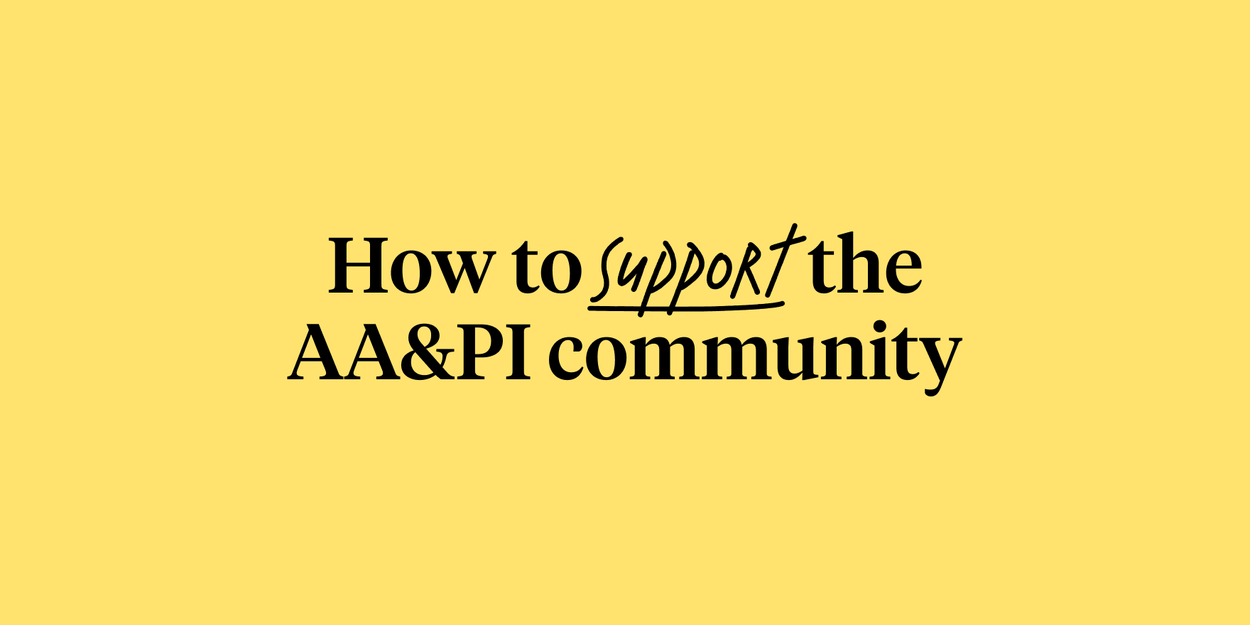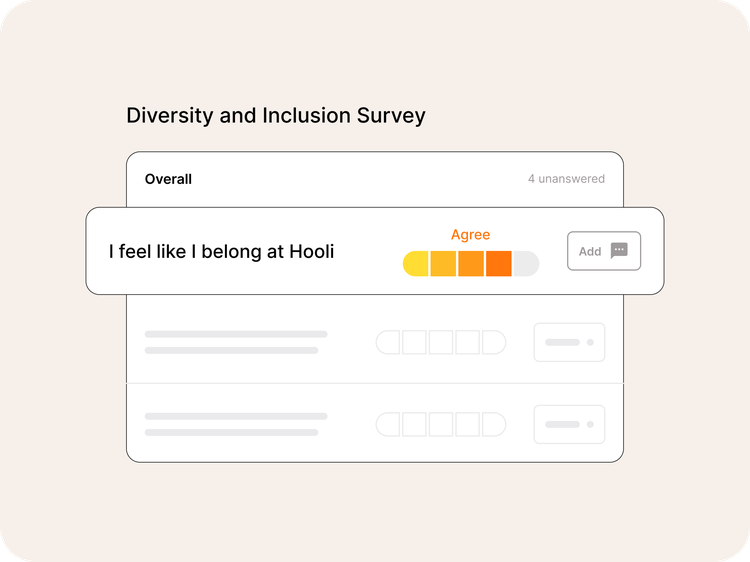
4 ways to support the AA&PI community in the workplace

Written by

Senior Content Marketing Manager, Culture Amp
Asian American and Pacific Islander (AA&PI) Heritage Month is almost half over – has your organization taken any meaningful steps to improve the experience of AA&PI employees at work? Celebrations are appreciated, but what AA&PI folks most want and need is tangible progress.
As discussed in the first blog in the series, we need to fundamentally disaggregate the way we understand, recognize, and measure “Asian.” When viewed and measured as an aggregate, the AA&PI community appears to be doing the best of any demographic group on average. These numbers, however, tell an incomplete and misleading story. Individuals, organizations, and institutions that only look at the average (i.e., all AA&PI) fail to see the needs and struggles of the least represented and most marginalized members of the AA&PI community.
Taking action to disaggregate data and educate oneself and others are fundamental first steps for any organization looking to meaningfully improve the experience of not just Asian American and Pacific Islander employees, but Asian employees in general – a particularly important point to keep in mind if you’re a global company.
In this article, I explore the AA&PI experience at work in greater detail and explain why intersectionality and data disaggregation are so crucial. This article also features three Asian Campers (what we call our employees), who share their experiences and what they believe leaders and individuals can do to better support the AA&PI workforce.
The AA&PI experience in the workplace
The model minority myth has excluded many AA&PI folks from important diversity, equity, and inclusion conversations. This is in huge part due to the belief that the AA&PI community is “better off” than other non-White racial/ethnic groups – a misconception that leaves many (especially the most vulnerable) Asian American and Pacific Islander employees feeling invisible, unheard, and unaccounted for.
The overrepresentation of certain East and South Asian communities in tech plays a major role in fueling this illusion. According to the US Equal Employment Opportunity Commission, Asian Americans make up 14.04% of employees at high tech companies, but 7% of the nation’s overall population.
Data aggregation, again, paints a biased narrative of AA&PI success that obscures and undermines the community’s lived experiences of inequities, microaggressions, and prejudice. Although the exact experience and degree of marginalization differ from person to person, there are general trends that can be observed among both less privileged and more privileged AA&PI groups (i.e., subpopulations with higher median household income and educational attainment).
Below are several data-backed examples depicting the struggles AA&PI employees face in the workplace.
-
Heightening workplace discrimination and xenophobia. The AA&PI community has experienced an alarming spike in racism, xenophobia, and hate crimes as a result of the ongoing COVID-19 pandemic. As a matter of fact, more Americans agree that Asian Americans are at least partly responsible for COVID-19 in 2022 than in 2021 – a misconception with no scientific or factual basis.
A 2021 IBV study investigating discrimination against AA&PI workers found that 8 in 10 Asian American respondents say that they’ve personally experienced discrimination based on their ethnicity or race. Nearly half of respondents pointed specifically to the discrimination they’ve faced in the workplace. Moreover, these figures were higher among senior and executive respondents, “an indication that the further they advance their careers, the more obstacles they confront.”
Examples of discrimination include: confusing one AA&PI employee for another (i.e., the Interchangeable Asian), racialized comments (including racial slurs and comments such as “Kung Flu” and “Wuhan Virus”), and physical violence. - Difficulty moving up the corporate ladder. A recent report by LAAUNCH found that almost 50% of Americans believe that Asian Americans are overrepresented or fairly represented in positions of power at companies and large corporations. In reality, Asian Americans are the least likely of all racial/ethnic groups to be promoted into management – a gap that has been attributed to cultural stereotypes about Asians and Pacific Islanders that conflict with Western ideals of leadership. This gap is especially stark for Asian women, who are some of the least likely to reach senior corporate leadership.
- Excluded from decision-making. Culture Amp’s 2022 Workplace DEI Report found that AA&PI employees don’t feel like their perspective is included in decision-making. As there are few (if any) AA&PI leaders and executives in a given organization, it makes sense that most Asian or Pacific Islander employees don’t feel like company-wide decisions consider their perspective.
-
Lack of belonging and inclusion. A recent survey conducted by Bain & Company found that Asian employees feel the least included in the workplace compared to other demographic groups. This is in line with LAAUNCH’s report, which found that only 29% of Asian Americans feel like they completely belong in the United States, compared to 33% of Black Americans, 42% of Latinx/Hispanic Americans, and 61% of White Americans.
A significant factor is likely the stereotype of Asian Americans and Pacific Islanders as “perpetual foreigners” – individuals who are perceived to be outsiders regardless of where they were born or how long they have lived in the US. Unsurprisingly, this stereotype can seep into workplace interactions, a reality that exacerbates feelings of exclusion and othering.
These examples and accompanying data suggest that many AA&PI employees face unfair promotion processes, lack a sense of belonging, and feel underrepresented in positions of influence at work, but that these struggles are largely invisible. To add to the burn, many companies do not consider Asian Americans an underrepresented group. Thus, they are often given little priority or attention in diversity programs, meaning that few organizations are taking action to improve the experience of AA&PI employees. This is despite evidence showing that AA&PI employees face barriers to promotion and career growth.
Intersectionality and data aggregation add to the complexity of this discussion. The examples above comprise just a few of the more general (and unfortunately aggregated) trends and findings around the AA&PI employee experience. Disparities compound and privilege accumulates. Accordingly, the experience of a third-generation Chinese-American man who speaks English as a first language is likely very different from that of a disabled Hmong woman who immigrated to the United States in her late teens. Each person’s identity and experience involve various intersectional layers, including the countries they have lived in, their national identity, their racial and ethnic background, and so on.
For all these reasons and more, it’s crucial to take an intersectional and disaggregated approach to understand and support the Asian and Pacific Islander workforce.
4 ways to support your AA&PI employees and coworkers
In writing this article, I spoke to three Asian Campers about their experiences and asked them to share what they think leaders and individuals can do to better support the Asian, Asian American, and Pacific Islander communities. Rather than specific actions, the suggestions below represent frameworks or considerations for how you can start taking meaningful action.
Below are the names and roles of the Campers I interviewed, as well as some of what they had to share:
- Thushy Muruges, Equitable Design Lead
- Vivian Woo, Lead People Science Analyst
- Lani Parrocha, Senior Channel Partnerships Manager
1. Collect demographic data on a granular level
Gathering demographic data is critical for understanding potential differences and disparities in employee experience among individuals with different backgrounds and personal identities. Unfortunately, companies that collect data on the AA&PI community tend to collect it at the aggregate level – something that we know erases significant differences between Asian American and Pacific Islander subpopulations.
Vivian Woo explains, “While it’s important to both report at the highest level so you have a large enough sample size to derive meaningful insights, organizations should also keep track of the details of people’s more granular identities. Knowing who your employees are is a critical first step in shaping their experience at work to be a positive and productive one. Having more data, rather than less, opens up more possibilities to leverage that information to make better decisions for your employees.
For example, instead of just collecting data on ‘Asian,’ you could collect data on specific countries of origin. It’s especially important for small companies to start this process in the early stages. It may be too early to take action on this data for some, but as your organization scales and your employee base grows and becomes more diverse, it will provide valuable insights to feed into all your people processes. Striving for specificity enables organizations to more meaningfully understand the nuances and complexities of the AA&PI experience.”
Aubrey Blanche, Culture Amp’s Director of Equitable Design, Product & People, suggests that companies begin by offering more specific choices when asking employees to provide demographic information. For example, AA&PI Campers at Culture Amp can choose between Central Asian, East Asian, South Asian, Southeast Asian, and Pacific Islander. Multiracial Campers can select an additional group.
2. Don’t forget about or exclude your non-American Asian employees
AA&PI Heritage Month is a United States-focused celebration, but it’s important to consider the non-American Asian and Pacific Islander experience, too. This is particularly true if your company operates globally, as the Asians and Pacific Islanders (API) working at your company may not necessarily be American or identify as American. Not every country has something like AAPI Heritage Month – so when or where are non-American API employees recognized or celebrated?
“There isn’t anything as widely acknowledged like AAPI month in the UK, nor is there one in Australia,” explains Lani Parrocha. Lani, who was born in Australia, worked in the United States during her early adult years and currently resides in the UK.
Lani continues, “I think AA&PI Heritage Month is an incredible opportunity for anybody who identifies as Asian or Pacific Islander, even if they aren’t American. It may not be the country I come from or currently live in, but I think it’s meaningful that in one part of the world, we’re being celebrated, we’re a part of something, and we belong to something. My hope is that in the future, every country can start to follow suit. Until then, it’s helpful for me to know that there’s a month every year where the API experience and identity is being recognized and celebrated.”
If your company doesn’t celebrate something like AA&PI Heritage Month for non-American API employees, strive to be as inclusive of these communities as possible. For instance, Camp Culture, Culture Amp’s employee resource group (ERG) for employees of different races and ethnicities, is hosting events across North America, EMEA, and APAC this month. Some of the events are focused on Asian Americans specifically, while others are intended to broaden understanding of the API community across different regions of the world. By putting a high level of thought and consideration into your Asian and AA&PI programming, your organization can promote higher levels of psychological safety, belonging, and inclusivity.
3. Celebrate, but stay critical
AA&PI Heritage Month, as Lani explains, can be an incredibly meaningful celebration. However, it’s crucial to ensure that celebrations acknowledge the progress that still needs to be made, especially when it comes to the least represented and most vulnerable members of the API community.
Thushy Muruges expresses, “While we want to celebrate the recognition and reward that the API community is getting, we also need to be critical of the pieces that are still missing. If you keep moving forward with just the majority voices, the minority voices are going to continue to be left behind and it will become increasingly difficult to pull them back up. The time to be critical is now.”
For example, is most of the AA&PI representation in your company East or South Asian? When you run community events, do most of the featured stories, experiences, movies, etc. focus on Chinese, Japanese, Korean, or Indian voices? Pay attention to the communities and intersectionalities that are likely being overlooked or overshadowed by the majority group, so that you can highlight them, too.
4. Run a DEI survey
Every organization is unique, so it follows that what the AA&PI employees at a given organization feel and want is unique, too. The best way to know how the AA&PI employees at your specific workplace are faring is to ask them directly.
That’s why Culture Amp strongly recommends running a DEI-specific survey. Although you can include DEI questions in a regular employee engagement survey, a DEI-specific survey will give you more targeted insights into DEI and the employee experience, the impact of your DEI efforts, and more.

For example, Culture Amp’s DEI survey collects feedback on the following factors:
- Belonging
- Fairness
- Opportunities and resources
- Decision-making
- Diversity
- Voice
- Contribution to a broader purpose
By looking at trends in responses among different groups of people, you can surface important insights into the AA&PI experience at your specific workplace. Of course, the more granular the demographic data is (i.e., Asians vs. Southeast Asians), the more accurately you can understand your workforce and improve the employee experience.
Move towards true understanding this AA&PI Heritage Month
The time has come to move beyond performative celebrations and towards meaningful actions that work to close disparities in the workplace and beyond. Although this month is a powerful one for many in the Asian and AA&PI community, we must remember to stay critical and seek measurable progress throughout the year.
The first step is to truly listen and understand. As a society, we must strive to ensure that the successes of certain subpopulations don’t overshadow the needs and vulnerabilities of the least represented groups. We can recognize the shortcomings of aggregate identities (AA&PI, Asian, Asian-American) while recognizing how these communities can find power and meaning in their shared, but diverse experiences of immigration, assimilation, identity-seeking, etc. Only by disaggregating our conception and understanding of “Asian” can we offer the whole AA&PI community the support it deserves.
This holds true for myself and others in the Asian, Asian American, or Pacific Islander community. Thushy puts it perfectly when she suggests, “Before we ask our allies to recognize our identities and uplift our voices, I would challenge those within the AAPI community to also uplift and recognize the differences amongst us.”
Inspired to take action in support of the AA&PI community? Here are some resources to get you started:
- StopAAPIHate is a great place to access resources, the latest news, and a portal for tracking hate crimes (available in 12 languages).
- Asian Americans Advancing Justice provides bystander intervention training to equip allies with techniques on how to safely intervene when they see or experience anti-Asian harassment.
- Anti-Asian Violence Resources compiles resources to help individuals educate others, take action, donate, and more.

Read the first blog in the series
“AAPI” is not a monolithic identity. This AAPI Heritage Month, let’s disaggregate how we conceive of, recognize, and measure the “Asian” identity.



